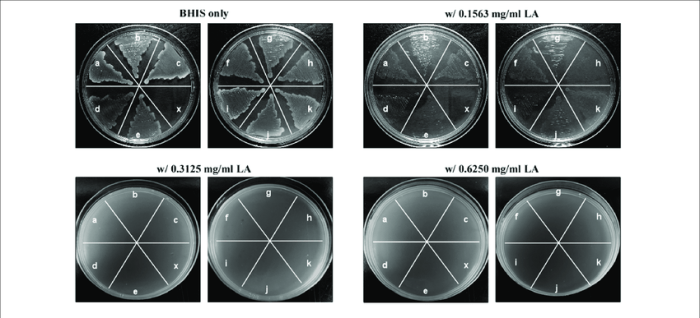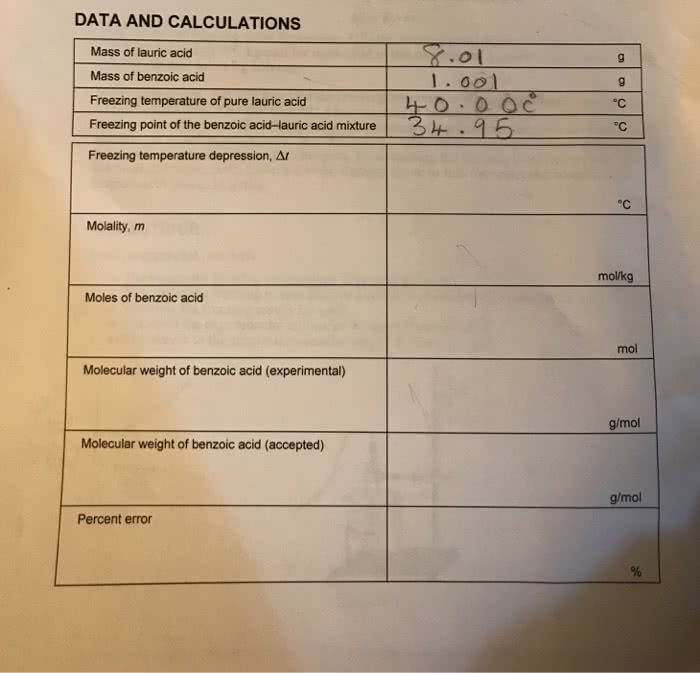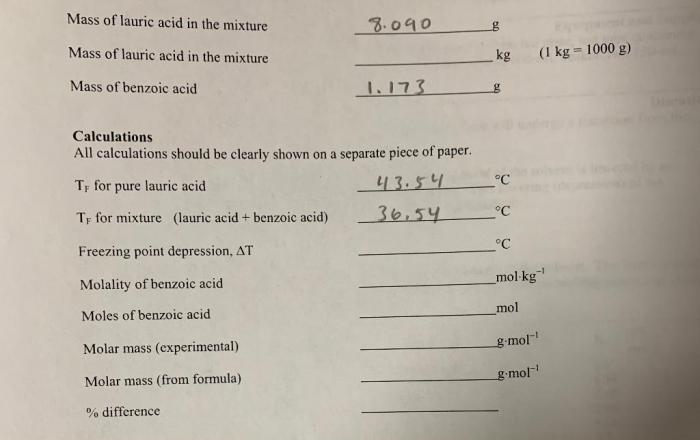Assume that a 1.5 g sample of lauric acid, a captivating journey unfolds, delving into the intriguing world of fatty acids. Its unique physical and chemical characteristics, diverse applications, and biological significance unveil a multifaceted substance with far-reaching implications.
Lauric acid, a saturated fatty acid, stands out for its distinctive properties and wide-ranging uses. From its role in personal care products to its potential health benefits, lauric acid’s versatility makes it a subject of great interest.
Physical Properties of Lauric Acid

Lauric acid, a saturated fatty acid, exhibits distinct physical properties. It is a white, crystalline solid at room temperature, with a characteristic soapy odor. Its melting point is 43.2 °C (109.76 °F), and its boiling point is 225 °C (437 °F) at 15 mmHg.
Lauric acid is insoluble in water but soluble in organic solvents such as ethanol and ether.
The chemical structure of lauric acid, CH3(CH2)10COOH, influences its physical properties. The long hydrocarbon chain contributes to its insolubility in water and high melting point. The presence of the carboxylic acid group (-COOH) allows it to form hydrogen bonds, which further contributes to its solid state at room temperature.
Chemical Properties of Lauric Acid: Assume That A 1.5 G Sample Of Lauric Acid
Lauric acid is a relatively stable compound. It undergoes typical reactions of carboxylic acids, such as esterification, amidation, and halogenation. However, it is resistant to oxidation and hydrolysis due to its saturated hydrocarbon chain.
Lauric acid can react with bases to form salts called laurates. These salts are water-soluble and have applications in the production of soaps and detergents.
Applications of Lauric Acid

Lauric acid finds applications in various industries, including:
- Soaps and Detergents:Lauric acid is a major component in the production of soaps and detergents. Its salts, laurates, have excellent cleansing properties and are effective in removing dirt and oils.
- Cosmetics:Lauric acid is used in the formulation of cosmetics, such as creams, lotions, and shampoos. It acts as an emollient, providing a smooth and moisturizing effect on the skin.
- Food Industry:Lauric acid is used as a food additive in the production of margarine, shortening, and other processed foods. It contributes to the texture and stability of these products.
- Pharmaceuticals:Lauric acid is used as a starting material for the synthesis of various pharmaceuticals, including antibiotics, antivirals, and antifungals.
Toxicity and Safety of Lauric Acid
Lauric acid is generally considered safe for use in food and cosmetic products. However, it can cause skin irritation and allergic reactions in some individuals.
When handling lauric acid, it is important to wear appropriate protective gear, including gloves and a mask, to avoid direct contact with the skin and inhalation of dust particles.
Sources and Production of Lauric Acid

Lauric acid is primarily obtained from the oils of plants such as coconut and palm. These oils contain high concentrations of lauric acid, which can be extracted through various methods, including solvent extraction and fractional distillation.
The production of lauric acid also involves the use of synthetic processes, such as the hydrogenation of vegetable oils. This method involves reacting vegetable oils with hydrogen gas in the presence of a catalyst, which converts unsaturated fatty acids into saturated fatty acids, including lauric acid.
Comparison with Other Fatty Acids
Lauric acid belongs to a group of saturated fatty acids known as medium-chain fatty acids (MCFAs). Compared to other fatty acids, MCFAs have a shorter chain length, which gives them unique properties.
MCFAs, including lauric acid, are more soluble in water than long-chain fatty acids. They are also more easily metabolized and provide a quicker source of energy.
Biological Functions of Lauric Acid
Lauric acid plays several important biological functions in the body:
- Metabolism:Lauric acid is a source of energy for the body. It can be broken down and used as fuel by cells.
- Immune Function:Lauric acid has antimicrobial and antiviral properties. It can help boost the immune system and protect against infections.
- Cell Signaling:Lauric acid can act as a signaling molecule in the body. It can bind to specific receptors and trigger various cellular responses.
Economic Importance of Lauric Acid

Lauric acid is a valuable commodity in the global market. It is primarily used in the production of soaps, detergents, and cosmetics, which are in high demand in both developed and developing countries.
The global market for lauric acid is expected to grow steadily in the coming years, driven by increasing demand from various industries. The major producers of lauric acid include Indonesia, Malaysia, and the Philippines, which account for a significant share of the global supply.
Question Bank
What are the physical properties of lauric acid?
Lauric acid is a white, crystalline solid with a melting point of 44.2 °C and a boiling point of 290 °C. It is insoluble in water but soluble in organic solvents such as ethanol and ether.
What are the chemical properties of lauric acid?
Lauric acid is a saturated fatty acid, meaning that it contains no double bonds between its carbon atoms. It is a weak acid with a pKa of 4.8. Lauric acid is reactive with bases, forming salts called laurates.
What are the applications of lauric acid?
Lauric acid is used in a variety of applications, including the production of soaps, detergents, and cosmetics. It is also used as a food additive and in the manufacture of pharmaceuticals.